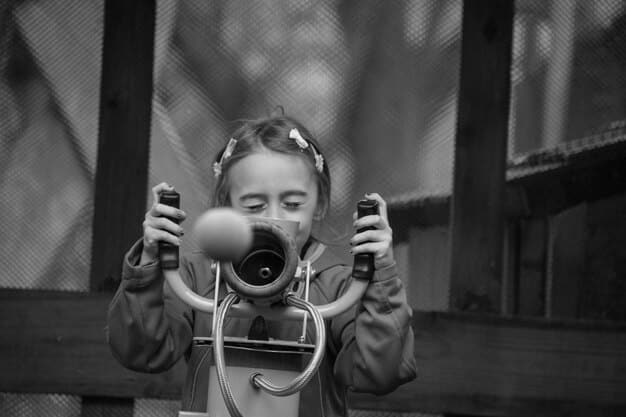Documentary Ethics Under Scrutiny: 3 Controversial Film Releases

Documentary filmmaking ethics are critically examined through the lens of three controversial releases, exploring the complexities and debates surrounding truth, representation, and consent in non-fiction storytelling.
The world of documentary filmmaking often grapples with ethical dilemmas, blurring the lines between truth-telling and exploitation. This article takes a documentary filmmaking ethics deep dive into three controversial releases, dissecting the choices made by filmmakers and their impact on subjects and viewers alike.
The Shifting Landscape of Documentary Ethics
Documentary filmmaking, at its core, strives to capture reality. However, the act of filming itself alters reality, and the choices made by filmmakers introduce layers of interpretation and potential bias. This section explores the evolving understanding of ethical practices in documentary filmmaking.
Defining Ethical Boundaries
What constitutes ethical behavior in documentary filmmaking? The answer is far from straightforward, as different filmmakers, subjects, and audiences may have conflicting perspectives.
The Power Dynamic
Documentary films often involve a power imbalance between the filmmaker and the subject. Recognizing and addressing this power dynamic is crucial for ethical filmmaking.
- Informed consent: Ensuring subjects fully understand the implications of participating in the film.
- Respect for privacy: Protecting subjects’ privacy and avoiding unnecessary intrusion into their lives.
- Fair representation: Presenting subjects in a balanced and accurate light, avoiding stereotypes or misrepresentation.

Documentary ethics is not a static concept; it evolves alongside societal values and technological advancements. As filmmakers gain new tools and techniques, they must also grapple with new ethical considerations. This requires a commitment to ongoing dialogue, self-reflection, and a willingness to learn from past mistakes.
Case Study 1: “Titicut Follies” (1967) – Exploitation or Expose?
Frederick Wiseman’s “Titicut Follies,” released in 1967, offers a stark depiction of life inside the Bridgewater State Hospital for the criminally insane. While lauded for its unflinching portrayal of institutional conditions, the film has been heavily criticized for its lack of informed consent and exploitation of vulnerable subjects.
The Controversy
“Titicut Follies” faced immediate legal challenges, with the state of Massachusetts successfully banning the film from public distribution for decades.
Ethical Breaches
The film’s primary ethical transgression lies in its failure to adequately protect the privacy and dignity of the patients. Many patients were filmed in highly vulnerable states, with little or no apparent consent.
- Lack of informed consent from patients deemed mentally incompetent.
- Graphic depictions of medical procedures without justification.
- Humiliating portrayal of patients, reinforcing negative stereotypes.
The case of “Titicut Follies” remains a cautionary tale, highlighting the importance of prioritizing the well-being and rights of subjects, even when seeking to expose important social issues. It demonstrates how good intentions can be undermined by unethical practices, ultimately jeopardizing the film’s credibility and impact.

Case Study 2: “Capturing the Friedmans” (2003) – Truth, Perspective, and Manipulation
“Capturing the Friedmans” (2003), directed by Andrew Jarecki, explores the story of the Friedman family, whose patriarch and son were accused of child sexual abuse. The film gained critical acclaim for its access and intimate portrayal, but also sparked controversy regarding its objectivity and manipulation of narrative.
Questionable Objectivity
The film relies heavily on home video footage and interviews with family members, presenting a fragmented and often contradictory picture of events.
Narrative Manipulation
Critics have accused Jarecki of selectively presenting evidence and manipulating the narrative to create ambiguity and cast doubt on the guilt of the Friedmans.
- Selective use of home video footage to create sympathy for the Friedmans.
- Downplaying evidence presented by the prosecution.
- Failing to adequately address the perspectives of alleged victims.
“Capturing the Friedmans” raises important questions about the role of the documentary filmmaker as storyteller and investigator. While the film offers valuable insights into the complexities of memory, family dynamics, and the legal system, it also serves as a reminder of the potential for bias and manipulation in non-fiction storytelling.
Case Study 3: “Leaving Neverland” (2019) – Believability and the Echo Chamber
“Leaving Neverland” (2019), directed by Dan Reed, features two men who allege they were sexually abused by Michael Jackson as children. The film generated intense media scrutiny and sparked a fierce debate about Jackson’s legacy and the credibility of the accusers.
One-Sided Storytelling
The film presents a powerful and emotional account of the alleged abuse, relying solely on the testimony of the two accusers, Wade Robson and James Safechuck.
Lack of Challenging Information
Critics argue that the film fails to adequately address conflicting evidence or consider alternative perspectives, creating an echo chamber that reinforces the accusers’ claims.
“Leaving Neverland” ignited a public firestorm, raising questions about the nature of truth, justice, and the power of storytelling. While the film provided a platform for the accusers to share their experiences, its selective presentation of evidence and lack of critical analysis fueled further division and controversy, challenging viewers to grapple with complex moral dilemmas. It underscores the responsibility filmmakers have to present a balanced and nuanced picture, even when dealing with sensitive and emotionally charged subject matter. The film’s impact extends beyond the specific allegations, prompting broader conversations about historical accountability.
The Impact on Documentary Subjects
Documentary films have the potential to significantly impact the lives of their subjects, both positively and negatively. Understanding these potential consequences is crucial for ethical filmmaking.
Potential Benefits
Documentaries can raise awareness about important social issues, give voice to marginalized communities, and inspire positive change.
Potential Harm
Documentaries can also expose subjects to unwanted attention, damage their reputations, or even put them in physical danger.
- Increased public scrutiny and judgment.
- Re-traumatization for subjects who have experienced trauma.
- Exposure to legal or social repercussions.
Documentary filmmakers must carefully weigh the potential benefits of their work against the potential risks to their subjects. This requires a commitment to transparency, empathy, and a willingness to prioritize the well-being of subjects above the demands of the film. By fostering open communication with participants, filmmakers can help to minimize potential harm and maximize the opportunities for positive impact. Ethical considerations need to be ongoing, not just a preliminary checklist.
Protecting Vulnerable Voices
Certain documentary subjects, such as children, individuals with mental health issues, or refugees, are particularly vulnerable to exploitation and harm. Extra precautions must be taken to protect their rights and well-being.
Additional Safeguards
Filmmakers working with vulnerable populations may need to seek additional consent from guardians or advocates.
Ensuring a Positive Impact
They should also take steps to ensure that the film benefits the subjects, rather than simply exploiting their stories for entertainment or profit.
- Providing subjects with access to mental health support.
- Sharing profits from the film with the subjects or their communities.
- Empowering subjects to tell their own stories and control their own narratives.
Ultimately, ethical documentary filmmaking requires a commitment to social justice and a deep respect for the dignity and rights of all individuals, especially those who are most vulnerable. This can involve collaborating with community organizations, seeking guidance from experts, and continuously reflecting on the potential impact of the film on the lives of its subjects.
Conclusion: Documentary Filmmaking’s Ethical Future
As documentary filmmaking continues to evolve, ethical considerations will remain at the forefront of the creative process. By embracing transparency, prioritizing the well-being of subjects, and engaging in ongoing dialogue, filmmakers can navigate the complexities of non-fiction storytelling while upholding the highest standards of integrity.
| Key Point | Brief Description |
|---|---|
| 🤔 Ethical Boundaries | Defining what is ethical in documentary filmmaking is complex and varies. |
| ⚖️ Power Dynamic | Recognition of power imbalance between filmmaker and subject is crucial. |
| 🗣️ Impact on Subjects | Documentaries can impact subjects positively and negatively, requiring care. |
| 🛡️ Vulnerable Voices | Extra precautions are needed to protect vulnerable documentary subjects. |
FAQ
▼
Key considerations include informed consent, protecting subject’s privacy, ensuring fair representation. Filmmakers should also avoid exploitation and minimize potential harm.
▼
Informed consent ensures that documentary subjects fully understand the implications of participating in the film, respecting their autonomy and preventing potential exploitation.
▼
Filmmakers can protect vulnerable subjects by seeking additional consent, ensuring a positive impact, and providing access to support services, safeguarding their well-being.
▼
Objectivity is challenging in documentary filmmaking. Complete objectivity is difficult, but filmmakers should strive for balance and transparency in their approach to storytelling.
▼
Ethical guidelines evolve alongside societal values, technology, and legal frameworks. This evolution requires constant reflection, updating ethical approaches, and a dedication to integrity.
Conclusion
Exploring the ethical dimensions of documentary filmmaking through these controversial releases highlights the crucial need for filmmakers to balance storytelling with a deep sense of responsibility. Prioritizing informed consent, minimizing harm, and promoting fair representation are essential for maintaining the integrity and positive impact of documentary films. The ongoing dialogue about ethical practices will undoubtedly shape the future of this powerful medium.





